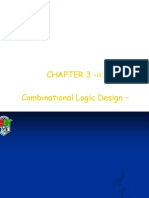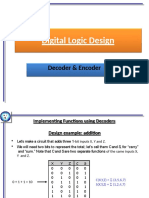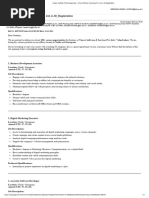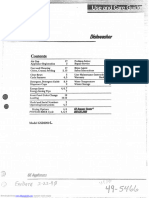Encode Encoder Decoder Priority Encoder
Uploaded by
rvi061705Encode Encoder Decoder Priority Encoder
Uploaded by
rvi061705Encoder, Decoder, and Priority Encoder
These are fundamental digital logic circuits used to convert information between different
formats.
Encoder
An encoder is a combinational circuit that converts information from one format to another,
typically from a set of input lines to a smaller set of output lines. It's like compressing
information.
● Types of Encoders:
○ Binary Encoder: Converts a decimal digit (0-9) into its 4-bit binary equivalent.
○ Priority Encoder: Assigns a priority to each input and outputs the binary code of
the highest priority input that is active. This is useful in scenarios where multiple
inputs might be active simultaneously.
○ Octal Encoder: Converts an octal digit (0-7) into its 3-bit binary equivalent.
○ BCD (Binary Coded Decimal) Encoder: Converts a decimal digit (0-9) into its 4-bit
BCD code.
Decoder
A decoder is a combinational circuit that performs the reverse operation of an encoder. It
converts information from one code to another, typically from a smaller set of input lines to a
larger set of output lines. It's like expanding information.
● Types of Decoders:
○ Binary Decoder: Converts a binary code into a decimal digit.
○ BCD to 7-Segment Decoder: Converts a BCD code into a 7-segment display
format.
○ Decoder with Enable Input: A decoder that requires an enable signal to activate
its output.
Priority Encoder
A priority encoder is a specific type of encoder that assigns a priority level to each input. When
multiple inputs are active, the output corresponds to the input with the highest priority.
Key Differences and Applications
Feature Encoder Decoder Priority Encoder
Function Converts many inputs Converts fewer inputs Assigns priority to
to fewer outputs to many outputs inputs and outputs the
highest priority input
Applications Keyboard encoders, Display drivers, Interrupt controllers,
multiplexer selection memory address data selectors
decoders
Example: 4-to-2 Line Encoder
A 4-to-2 line encoder has four input lines (I0, I1, I2, I3) and two output lines (Y1, Y0). It converts
the active input line into a binary code on the output lines.
Example: 3-to-8 Line Decoder
A 3-to-8 line decoder has three input lines (A, B, C) and eight output lines (Y0, Y1, ..., Y7). It
activates one of the eight output lines based on the binary code on the input lines.
By understanding these fundamental concepts, you can design and analyze various digital
circuits and systems.
You might also like
- A Comprehensive Overview of Encoder CircuitNo ratings yetA Comprehensive Overview of Encoder Circuit8 pages
- Decoders and Encoders 16th October 2017No ratings yetDecoders and Encoders 16th October 201753 pages
- Lesson 4 - Decoders and Encoders 13th January 2023No ratings yetLesson 4 - Decoders and Encoders 13th January 202353 pages
- Digital Logic Design: Decoder & EncoderNo ratings yetDigital Logic Design: Decoder & Encoder20 pages
- The Digital Encoder: 4-To-2 Bit Binary EncoderNo ratings yetThe Digital Encoder: 4-To-2 Bit Binary Encoder10 pages
- Priority Encoder: 4-To-2 Bit Binary Encoder100% (1)Priority Encoder: 4-To-2 Bit Binary Encoder6 pages
- 06 - Combinational Logic - Coders EncodersNo ratings yet06 - Combinational Logic - Coders Encoders24 pages
- Lecture4B - Functions of Combinational LogicNo ratings yetLecture4B - Functions of Combinational Logic79 pages
- Encoders and Decoders, Multiplexer, Tri-State InverterNo ratings yetEncoders and Decoders, Multiplexer, Tri-State Inverter25 pages
- Over 100 Data and Analytics Predictions Through 2028 1No ratings yetOver 100 Data and Analytics Predictions Through 2028 127 pages
- Packaged Palm Cooking Oil Business Process Design in IndonesiaNo ratings yetPackaged Palm Cooking Oil Business Process Design in Indonesia13 pages
- Ab Ipbox 55Hd: Receptor HDTV Com Sistema LinuxNo ratings yetAb Ipbox 55Hd: Receptor HDTV Com Sistema Linux8 pages
- Vinove Software & Services Pvt. Ltd. - JD - RegistrationNo ratings yetVinove Software & Services Pvt. Ltd. - JD - Registration3 pages
- Key Points: EPC4 Weekly Report 22 February 2011 Teamwork at Its HighestNo ratings yetKey Points: EPC4 Weekly Report 22 February 2011 Teamwork at Its Highest7 pages
- Schneider Electric Altistart DTM Library V12.0.0No ratings yetSchneider Electric Altistart DTM Library V12.0.03 pages
- Engineering Ethics Chapter One Engineers Professionals For The HumanNo ratings yetEngineering Ethics Chapter One Engineers Professionals For The Human16 pages

























































































